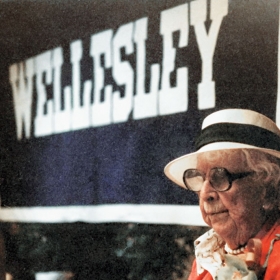Marjory Stoneman Douglas 1912
Marjory Stoneman Douglas, class of 1912, is posthumously serving as the backbone of a new national movement led by students that is breathing life into the nation’s gun control conversation. It’s a role she likely would have embraced.

Marjory Stoneman Douglas, class of 1912, was in headlines around the world this February as the namesake of the Parkland, Fla., high school where a gunman opened fire, killing 17.
But her legacy goes far beyond those headlines. Douglas is posthumously serving as the backbone of a new national movement led by students that is breathing life into the nation’s gun control conversation. It’s a role she likely would have embraced.
Douglas, who died in 1998, was a pioneering environmentalist, journalist, and advocate. By all accounts, she exuded strength and a desire to improve the world around her. Her life’s mission was the conservation of Florida’s Everglades.
It’s hard to imagine a time when the Everglades’ “vast glittering openness” was considered worthless. But for hundreds of years, Douglas writes in her seminal 1947 book The Everglades: River of Grass, they were described as “vast, miasmic swamps, poisonous lagoons … a rotting, shallow, inland sea” and “malignant with tropical fevers and malarias, evil to the white man.” In River of Grass, Douglas describes the Everglades’ ecosystem in poetic, painstaking detail: the rock beneath Lake Okeechobee, the sweeping saw grass, the tall pine trees. All written as a warning to Floridians that, as she begins the book, “there are no other Everglades in the world.” It worked. Public perception shifted, and at the end of the year, 1.3 million acres was dedicated Everglades National Park by President Harry Truman.
Douglas also cared deeply about writing, feminism, and civil rights. She served with the Red Cross during World War I in Europe, was a long-time journalist, young-adult writer, and a founder of the Miami-Dade library system. She fought for suffrage and the rights of migrants and African-Americans in Miami.
As Wellesley and the Orlando Sentinel noted at her death, Douglas had a “strong, persistent voice, powerful enough to relay her passion to the masses.”
That voice still echoes in the hallways of Marjory Stoneman Douglas High School. Emily Pierson ’04, who attended in the 1990s, recalls discussing “her activism and how inspiring she was in her dedication, even at 100-plus years old.”
While at the White House to receive her Presidential Medal of Freedom in 1993, Douglas saw President Bill Clinton sign the Brady Bill, which mandated waiting periods and background checks for those wanting to buy a handgun.
Donna Ballman ’81, who knew Douglas through her local Wellesley club, sat next to her at the signing. “She made it clear that she was very proud to be witness to President Clinton taking action on gun safety,” Ballman says.
In the wake of the Parkland shooting, Marjory Stoneman Douglas High School students have organized a vocal national movement, hoping to spark the next wave of gun control legislation. They are using their strong, persistent voices to relay their passion to the masses—following her example. “Marjory, had she been alive, she would have been right there in the middle of it,” Ballman believes. “She was not one to sit down and be quiet.
“Her legacy is these marvelous, well-spoken students who are speaking up for the school that carries her name,” Ballman says. “She would have been so proud of these children. … [The school] taught their students to stand up and be active, and that’s what they’re doing.”
Ballman, who lives in the same county as Parkland, attended a gun-control rally a few days after the shooting with her high-school-aged daughter, where there were signs calling out the NRA and calling for bans on assault-style weapons. Ballman held up a sign that read “Marjory Stoneman Douglas was a national hero” and “I’m here for her.”

